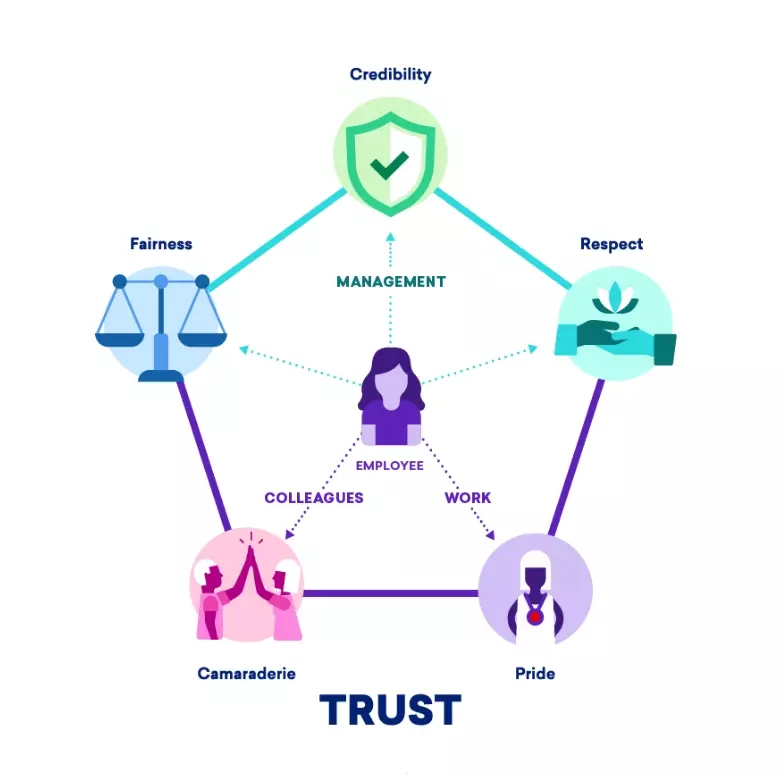With seemingly endless modern job perks on the rise, HR professionals at small businesses may be wondering how they can compete with larger organizations to attract and retain the best talent. For an already resource-strapped company, it can be overwhelming to think about spending more time and money to win the war for talent against those with big budgets and dedicated teams focused on culture and engagement.
But it's critical not to get lost in the noise here. Instead, when competition for talent is high, smaller organizations need to ask a simple question as they wade through all the perks and initiatives their larger counterparts engage in — is that what really matters to people?
We can all agree that free food and office yoga classes are nice incentives, but research from Great Place to Work® shows that employee retention is less about the perks and more about creating a company culture of care. It’s about trust, leadership, human connection, wellness, and belonging, diversity, equity, and inclusion.
So with that in mind, what should small businesses rally around to create stand-out cultures? Let's take a look.

What's easier for small businesses?
Because small businesses are, well, small, it’s easier for them to build and foster trust — the defining component of a great workplace. Whether it’s more transparency or less corporate hierarchy, small businesses can use this advantage to find and keep the talent they need to thrive.
After all, a great workplace is one where employees trust the people they work for, have pride in what they do, and enjoy the people they work with. And if size doesn’t dictate great culture, then yes, a small business can be a great place to work with the right mix of core values.
As we get into some more specific examples of how HR pros at small businesses can use the advantages they have to build an employer brand and invest in company culture, take a look at the diagram below to see the five core elements of building trust with employees and where in the organization employees look for those elements:

What can small businesses do to create great workplaces?
There's no single blueprint or one-size-fits-all approach to building a great place to work. There are, however, some common areas you should investigate as starting points. Looking into the following areas may help you map the key points in an employee's journey with your company and reinforce cultural values like trust, respect, purpose, and community.
Start day one off strong with a thoughtful onboarding process
Employees want to feel connected to the organization, and as a small business, it’s easier to make that personal from the beginning. A positive first impression is imperative to an employee's long-term wellbeing, and people often form that impression before they even join your organization. Completing redundant tasks and leaving new hires wondering what steps to take next will negatively impact their overall experience. By connecting your recruiting and core HR processes, you can ensure new hires trust that their success is top of mind for their manager. Looking for a specific idea? Try building out individualized 90-day action plans as part of your onboarding experience.
Prioritize career development
Have you heard of an internal talent marketplace? It's a more efficient, technology-driven employee management and retention system. It leads to better retention through tracking the skillsets of employees and helping them to further develop and build upon those skills, and it works with them to build a career path within the organization. To do this, there needs to be a commitment to support fair and consistent performance and succession strategies that identify, nurture, and develop top talent. Small businesses often have flat structures, which allows employees more visibility and connection. These broader learning opportunities ultimately keep everyone invested in the company’s culture, and both internal and external job seekers will view your organization as one that prioritizes career development.
Focus on all aspects of wellbeing
Great Place to Work surveyed over 14,000 people from 37 countries to better understand trends in the average worker’s day-to-day experiences of wellbeing in their workplace, and found that while employee experience is influenced by many factors, there are a few key areas HR needs to focus on to promote positive employee wellbeing:
- Mental and emotional wellbeing: The first step in promoting mental health at work is to talk about it. Over the last two years, mental health has come to the forefront for many of us as we experienced the pandemic, the challenges of navigating remote work, and social unrest. This is an issue that affects all people, at all levels in an organization. Mental wellness check-ins, providing resources, and offering formal programs are becoming priorities for many organizations moving forward.
- Sense of purpose: Aligning an individual’s role with the organization’s mission correlates to a higher sense of purpose, which has been linked to higher resilience and more favorable views of employers. We’ll talk a little bit more about purpose later.
- Personal support and meaningful connections: When employees are given proper resources and workplace flexibility, they’re more likely to have a positive sense of wellbeing. Supportive social relationships within a team are also important, as an environment of equity and inclusion is necessary to create psychological safety and teamwork.
- Financial wellbeing: Many people spend a significant amount of time worrying about their personal finances at work. It’s important that employees earn enough to feel financially stable, and that your workplace promotes equal pay practices, but what more can be done? Offering programs that give employees access to their pay before pay day, for instance, has been linked to improvements in productivity and reduced absenteeism.
Celebrate your people's achievements to foster a sense of purpose
Nearly 50 percent of respondents from the Great Place to Work survey mentioned earlier reported not finding meaning in their work, while 39 percent felt their work does not make a difference. With both consistent and significant gaps in purpose and connections, two areas needed to flourish at work, it’s apparent that organizations need to focus their efforts on building a sense of belonging in the workplace. When an individual can see how their work makes a meaningful contribution to the organization, they take more pride in what they do. Knowing that one person can make real change — and that it's possible to have authentic and caring connections at work — is often why job seekers are attracted to small businesses.
Keep a pulse on your culture's development
Identify the needs and sentiment of your people to help them feel heard, and to identify what matters most, with regular surveys. Wondering how to plan your survey strategy or how often to survey your employees? Again, there’s no single answer. Most companies survey their employees once a year, though you may have reason to do so more often (think feedback on remote work and the pandemic). Survey fatigue is real, but typically only occurs if leadership is not making any positive change based on employee feedback.
Conclusion: Let's champion great workplaces together
If you’re looking for even more inspiration on how to create a great workplace, register for our next HR & Payroll eSymposium – it’s free, and you'll receive credits toward your SHRM, APA, HRCI, HRPA, CPHR-SK, and National Payroll Institute certifications for most sessions. Michael C. Bush, CEO of Great Place to Work, will be there for our closing keynote to discuss the importance of prioritizing a culture of inclusiveness, how creating an equitable work environment pays off, and how to drive personal performance with the For All™ leadership model.



